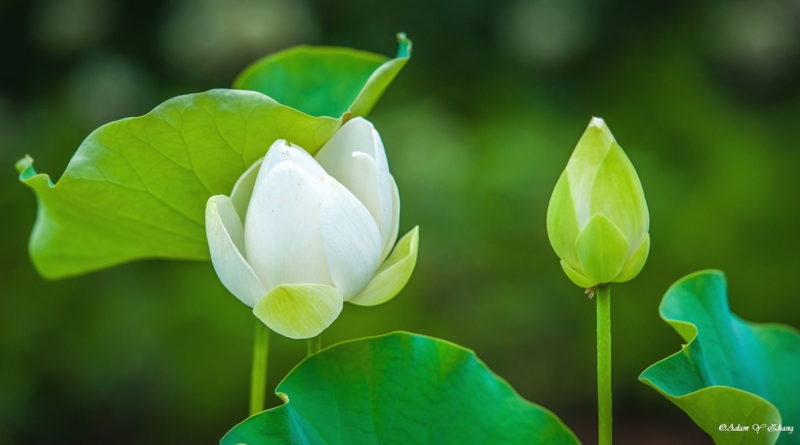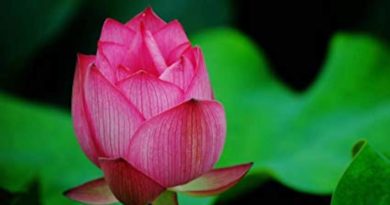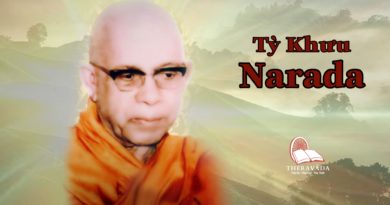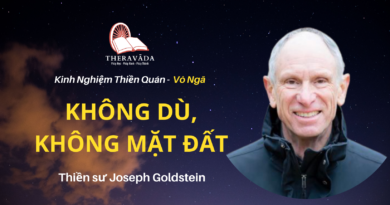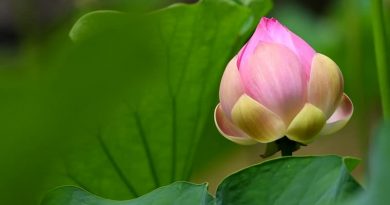DHAMMA RATANA – CHAPTER 6: FOUR CONSTITUENTS FOR SOTAPAN AND SIX BENEFITS OF SOTAPAN
MAIN CONTENT
DHAMMA RATANA – CHAPTER 6: FOUR CONSTITUENTS FOR SOTAPAN AND SIX BENEFITS OF SOTAPAN
Today’s sermon will be on “four constituents to be a sotapan and six benefits of sotapan’. Lord Buddha had pointed out the four constituents for those who sincerely aspire to be a sotapan in this very life.
They are: –
1. To take refuge in noble masters.
2. To listen to noble dhamma
3. To develop proper attitudes in order to gain merits
4. To practise dhamma adaptive to Magga and Phala
The Buddha’s advice is very much appropriate for the listeners of today’s discourse. It is a necessity, to have these four constituents, to be a sotapan.
Motto: Take refuge in noble persons, listen to dhamma (Develop proper attitude and) practise for magga and phala
These are the four required for a sotapanna.
1. To Take Refuge in Noble Teachers
In Buddha’s time, of course it is the Lord Buddha in whom we should take refuge. However, in the absence of the Lord, we should take refuge in arahats; if arahats are not to be found then take refuge in an anagan; if not possible it is Sakadagam; if not take refuge in a sotapan. Even if a sotapan is not available, then the guardian of three pitakas (3 Baskets), if not then the guardian of 2 pitakas; if not then the guardian of one pitaka. When a guardian of one pitaka is not within reach then take refuge in those who practise vipassana meditation. Listeners of this discourse surely have taken refuge in sayadaws. Then you have the first constituent for a sotapan.
2. To Listen to Noble Dhamma
Except Buddhas and Silent Buddhas (Individually Enlightened Ones) no one could he a sotapan without the audition of dhamma. To listen to dhamma is like watering a young mango plant. While practising vipassana you feel quite happy and make progress after listening to dhamma. A young plant grows well and bears flowers and fruits if it is regularly watered. Similarly by listening to dhamma you gain magga and phala. If you failed to listen to dhamma, like an unwatered young mango plant you feel depressed, and you would like to leave the mediation centre: the young mango plant dies when not regularly watered. Likewise. if you leave the meditation centre, you are just like the dead. If you do not want to die, like the withered plant. then listen to dhamma without fail.
3. To Develop Proper Attitude
In order to gain merit you should develop proper attitude.. You will come across pleasant as well as unpleasant sensations whether you desire it or not. When it is a pleasant one you develop lobha by getting attached to that pleasant experience. How to develop a proper attitude in such a case? Instead of developing attachment to it, reflect thus, “I have pleasant and happy experience now, because I have done nothing good in the past existences. To be happy in the future, I must carry out good deeds at present.” Then you would engage in more meritorious deeds to gain happiness and consequently attain nirvana. If it is unpleasant, dosa would arise leading to unwholesome deeds. Here also you should ponder, “Things are unpleasant and I’m unhappy. This is so because I’ve done bad deeds in the past existences. I must be good in this present life, so that I wouldn’t have unpleasantness in the future.” Thinking thus you expel dosa.
Ill-effects, certainly are the results of bad deeds. However if you can develop a proper attitude towards it, reflecting as mentioned above, the ill-effect will become the cause of good deeds as you will shy away from unwholesome deeds. Thus there is no more danger of suffering in apaya. To become a sotapan you must harbour a wholesome mind instead of an unwholesome one. If you have an unwholesome mind, undoubtedly you will never be a sotapan. Unwholesome mind and noble dhamma are antithesis.
4. Practice adaptive to Magga and Phala
The listeners of this sermon are practising vipassana meditation according to Rev: Mahasi Sayadaw’s instruction with an aspiration for nibbana. When you offer dana alms- food, etc., you pray for the attainment of nibbana. At the end of receiving precepts sila you again pray for magga and phala. Thereupon it is evident that you have an inclination towards nibbana, whatever and whenever good deeds you carry out. Since these dana and sila are the supporting factors for the attainment of nibbana, they can be regarded as practices adaptive to magga and phala. Nevertheless the best practice is vipassana meditation under correct guidance. Rev: Mahasi Sayadaw had instructed explicitly how to practise vipassana meditation. Not only that he had also composed many mottos for the same purpose, like the following one.
Motto: Q. What is to be noted for the development of vipassana wisdom?
A. The correct way is to note the five groups of clinging.
The five groups of clinging are the five aggregates which form the objects of clinging. You grasp these five aggregates with craving, incorrect view, etc.:- You find these five aggregates within yourself as well as in others’ selves. Then which is to be noted? Of course, it is to note the aggregates in yourself. Vipassana Meditation by guessing aggregates in others’ selves is not the correct way. First you must contemplate your own five aggregates; then you will gain dhamma. When you comprehend the nature of your own aggregates, then only you will be able to perceive the nature of others’ aggregates. Since no clinging to your own aggregates is developed, there will be no grasping of the others too.
Motto: Q. Why and when those aggregates must be noted?
A. They must be duly noted at the moment of becoming, to prevent clinging.
Many foreigners take interest in Buddhism, especially vipassana meditation. They would like to know why one needs to practise vipassana meditation. Is it to have the mastery of clairvoyance and clairaudience? A young student once asked sayadaw, “I would like to practise vipassana meditation. How many days do I need to master clairvoyance and clairaudience?” In fact, vipassana meditation is not for prosperity in business nor to gain the power such as clairvoyance and clairaudience. It is to eradicate cravings and clinging to the aggregates. In other words, it is to be free from sufferings and to realize nirvana. In order to develop vipassana wisdom, it is therefore, important to note at the moment of becoming, that means to note the present, not the past which is gone nor the future which does not exist yet.
Motto: Reflect not upon the bygone past nor expect the new future.
Note the present moment of becoming dissolution of rupa and nama for sure.
Out of past, present and future, it is to note objectively the present moment. If late for a fraction of second dhamma is past and gone. Thereupon other thoughts such as wrong view, sensual attachment, etc.: will take its place and progress in dhamma is stagnant. If you thought of the future and reflected “whether I gain dhamma”, your mind is wandering and there is no chance for the attainment nibbana. Therefore it is to endeavour to note at the moment of occurrence and not to reflect upon the past nor to expect the future. In practising meditation, it is required to note the external as well as internal objects of noting. When vipassana wisdom is immature, it is better to note what is happening in your body (kayanupassana). Out of four foundations of mindfulness, it is most feasible to note the body which is inclusive of all behaviour and action such as sitting, touching, rising, falling, standing, bending, stretching, etc:- The whole body is covered with receptacles (sensual surfaces – kayapasada) except the nails and tips of hair. These are the internal objects of noting.
At the Bhanga Nana Stage where concentration is mature to a certain extent, you begin to perceive the nature of dhamma. You will be able to note the external object of noting such as seeing, hearing, taste, smell and thinking. How one could know that he is at the Bhanga Nana Stage? At this stage wisdom develops and dissolution is very lucid to the practising yogi. He will be able to note the external objects of noting as mere seeing, mere hearing, etc. while noting “rising” “falling” the initial stage of rising and that of falling are not apparent to yogi, however the end or disappearing is very vivid. He is no longer concerned with pannatta. In sitting practice, form of body, legs, hands, etc. are not clearly perceived but yogi is aware of stiffness of his body (as pushed by the element of motion.) All the time what he is noting is dissolution. It will be more distinct if he developed a disposition towards it. At every noting he comprehends vanishing behaviour and action.
With full development of the Bhanga Nana Stage, the object of noting, the noting mind and conscious mind disappear whenever yogi notes. For example, in sitting practice when he notes “sitting” “sitting” the form of sitting body and the noting mind vanish and he is only conscious of the element of motion pushing the body. So also in all other postures of practice. This is the first factor in strengthening the controlling faculties. In other words, it is the attention directed towards impermanence of all objects of consciousness. Since the new yogi has learned about this first factor by listening to the sermon, he is very much interested to perceive the process of becoming and dissolution. As he is still at the Udayabbaya Nana Stage, his concentration is not strong enough and wisdom has not well developed, he would not be able to do so. He has to strive hard to note successively and continuously. Then he will perceive the dissolution of both the object of noting and the noting mind.
The process of becoming and dissolution is so fast that yogi could not keep pace with it and also the same time he realizes that the psycho – physical phenomena is impermanent i.e. anicca, to be harassed by this fast process of becoming and dissolution is suffering, i.e.,dukkha; this harassment is uncontrollable and unobstructable i.e., anatta. With distinct comprehension of the three characteristics no clinging arises, thereupon it is a certainty that yogi would be liberated from sufferings; at first he clings to his own aggregates and afterwards it is the others’ aggregates that is craved for. Whereupon there is no chance of liberation. Therefore it is important to practise vipassana meditation.
With the maturation of vipassana wisdom, awareness of fright and fear arises in the wake of constant and rapid dissolution of all phenomena – Bhaya Nana Stage. Thus it comes to be realized these rapidly dissolving nana and rupa are undesirable dhamma of inferior and evil nature -Adinava Nana. Such rapid dissolution of nama and rupa are then seen to be unsubstantial, devoid of pleasure and tiresome. -Nibbida Nana. With the strengthening of Nibbida Nana which sees and knows all nama and rupa are suffering, a desire arises to renounce this body – mind complex -Muncitu kamyata Nana. With the arising of this desire one realizes, the need for further effort by noting so that one may be able to renounce -Patisankha Nana. Sometimes yogi does not put effort and let go without noting. Since the momentum of noting has gained, noting goes on of its own accord.
The Six Benefits
So far we have discussed the four constituents for a sotapan. Buddha had explained that there are six benefits enjoyed by a sotapan. They are:
1. Firm establishment in wholesome dhamma
2. No regress in wholesome dhamma
3. Limitation of number of existences to suffer
4. Development of higher wisdom which is not pertained to puthujjanas
5. Perfect knowledge of causes
6. Comprehension of effect in accordance with cause
1. Firm Establishment in Wholesome Dhamma
A sotapan is unlikely to infringe five, eight and nine precepts or moral conduct and the 37 constituents of enlightenment. A sotapan always observes wholesome dhamma especially the five precepts even at the risk of his life. For example bad people with dominating influence threatened to kill him if he failed to kill someone; that he would be killed if he did not steal; that he would be killed if he refused to commit adultery; that he would be killed if he did not take intoxicated drinks; that he would be killed if he refused to tell lies to ruin others. A sotapan will never commit deeds which infringe the five precepts even if there arises opportunities to do so. This firm and unshakable moral conduct is the landmark of a sotapan. Therefore a sotapan will be liberated from sufferings in this existence as well as in the following existences as he is well established in dhamma.
Motto: When in dhamma firmly established You already gain the benefit.
2. No Regress in Wholesome Dhamma
There is no regress in observing wholesome dhamma such as faiths moral conduct, moral shame, moral dread, knowledge, charity and wisdom. It is not only in this very life, even after death the merits of observation of these wholesome dhamma do not regress, in fact they even propagate. Faith in a sotapan is so firm and strong, that no one has to persuade him to give dana. In this meditation centre, yogi who have gained dhamma are so enthusiastic to give dana that they have to be requested to wait for the proper time. In this centre it is not allowed to persuade anyone to offer dana. The volitional donation is more beneficial than the one persuaded by others. Donation out of own faith leads to the attainment of higher magga and phala. Better existence are also the results of such dana.
Motto: No regress in dhamma
Has a benefit of good result
3. Limitation of Number of Existences
Number of existences for a Sotapan is limited to only seven existences to undergo sufferings. Once at Zetavon Monastery, Savatthi, as there was no time to preach, Buddha put some earth dust on his thumb nail and said, “Which is more my good sons, the earth dust on my thumb nail and the dust on the earth of the world?” The monks replied that they were incomparable and definitely the earth was much more. Then the Lord explained, “The amount of earth dust on my thumb nail is comparable to the amount of sufferings that a sotapan, in the presence of sasana has to undergo. The number of existence to suffer is limited for a sotapan. The amount of sufferings he has already discarded is comparable to the dust on the earth. (ref: Nakhasikha Sutta)
Motto: The dust on the nail is equal to the remaining sufferings
The dust on the earth is equal to the expelled sufferings
A sotapan has gained the benefit of limited sufferings
4. Development of Higher Wisdom
A sotapan has developed higher wisdom which is unrelated to puthujjana. Once a yogi after attainment of dhamma said, “I could not grasp the meaning of dhamma explained in the book on vipassana before. Now everything in the book is so lucid to me that I read it over and over again.” Being a sotapan he has a higher wisdom and could enjoy the dhamma. Since he has completely discarded incorrect views and doubts, his mind is free from defilements and his wisdom is more clear and bright. In puthujjana, doubt such as “Will I gain dhamma just by noting “rising”, “falling”, “sitting,” “touching”, is a great hindrance to the progress of dhamma. With such doubts in mind it is also unreliable for the freedom from apaya. Since a sotapan has eliminated these two defilements, his mind is lucid and higher wisdom develops.
Motto: The benefit attained by sotapanna
Is the higher wisdom not concerned with puthujjana.
A puthujjana usually harbours incorrect views and doubts and also gross kilesa such as lobha and dosa in his mind. However a sotapan has dispelled incorrect views and doubts and no longer develops harsh mind which is the cause of sufferings. Moreover he has discarded lobha, dosa and moha which lead to apaya. Thence he is undoubtedly liberated from sufferings in apaya. Moha ignorance is the darkest of the three unwholesome dhamma and deters the development of wisdom to decide right and wrong.
5. A Perfect Knowledge of Cause
A sotapan has perfect comprehension of cause; for instance, he can definitely decide, what is the cause; which cause is wholesome or unwholesome. The reason is that a sotapan has a higher wisdom than a puthujjana. He also perceives clearly that the wholesome cause will produce wholesome benefit. For example you aspire for the attainment of nibbana however, you practise a self-harassing method. Would you gain nibbana? Since the cause (self harassing practice) is not the right method for the effect (nibbana) you are apart from nibbana. The insight meditation is the correct method for the realization of nibbana.
To be more explicit, here is another illustration. At mid-day, one sits in the middle of four big fires (Pancatapa Practice), believing that all kilesa will be burnt by the heat of four big fires and the mid-day sun (is very hot especially in India). Perhaps he may not develop craving (kilesa), however he is in anguish of the heat, that is dosa; he is also anxious whether he would be able to stand the heat, that is doubt. With anger and doubt could one expect to gain nibbana? All these are the results of unwholesome cause- self harassment practice. A sotapan has eradicated all doubts and wrong causes, and developed higher wisdom. Therefore be is in the know of the relationship of right cause and right effect.
Motto: Knowledge of a correct cause is the benefit of a sotapan
Knowledge of the cause which is hard to perceive is gained by a sotapan.
6. Comprehension of Effect
Unlike puthujjana a sotapan can perceive distinctly what cause can produce what benefit. The wholesome benefits are the products of wholesome physical and verbal action and thoughts. “One suffers unhappiness because of his unwholesome physical, verbal and mental deeds”, thus . a sotapan understands better about the relationship of cause and effect. Thereupon he suffers less as he could not commit misdeeds.
Motto: Knowledge of the effect which is hard to perceive Is the benefit a sotapan receives.
A sotapan can comprehend clearly what is difficult for a puthujjana such as good deeds return good benefits; unwholesome deeds deserve unwholesome benefits. In other words, when one has done good deeds, one will enjoy happiness and be free from suffering and pain. Without the knowledge of the fact that unwholesome effects are the results of unwholesome deeds, a puthujjana is bound to commit misdeeds. Thereupon he will be unhappy and sorrowful. However he could not understand why he has to suffer but not the others. On the other hand, a sotapan even with a mediocre wisdom has the ability to perceive the right relationship of cause and effect.
Some Heads of Departments confirmed that vipassana meditation is a great help in making important decision in their work. Though it takes time out from his work, he realized that vipassana meditation made his mind lucid and right. He meditates an hour a day without failure. The correct and quick decision is the benefit of clear mind, the outcome of vipassana meditation.
After listening to this sermon “four constituents for a sotapan and six benefits of sotapan” may you all be able to practise in accordance with the Buddha’s instruction. With diligent contemplation may you all be able to practise with ease and immediately realize your most aspired Nirvana which is free from all sufferings.

